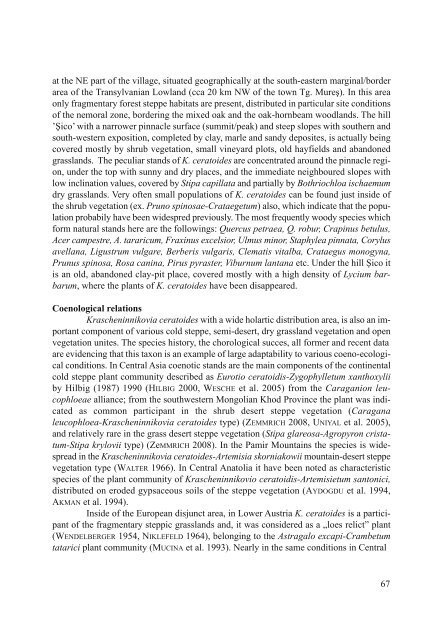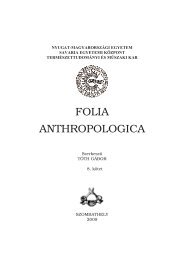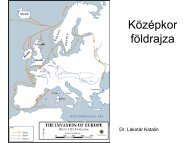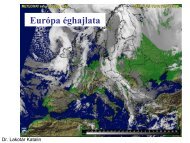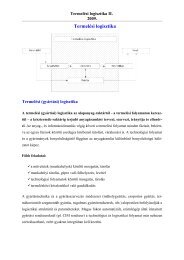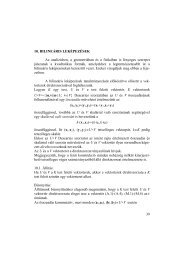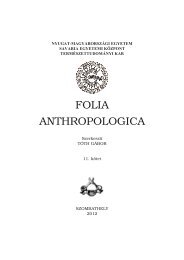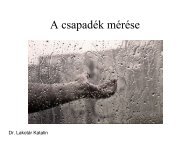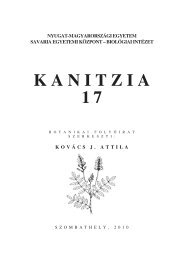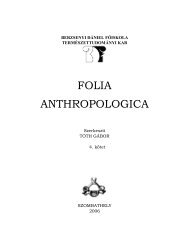Kanitzia 18. - NYME Természettudományi Kar - Nyugat ...
Kanitzia 18. - NYME Természettudományi Kar - Nyugat ...
Kanitzia 18. - NYME Természettudományi Kar - Nyugat ...
Create successful ePaper yourself
Turn your PDF publications into a flip-book with our unique Google optimized e-Paper software.
at the NE part of the village, situated geographically at the south-eastern marginal/border<br />
area of the Transylvanian Lowland (cca 20 km NW of the town Tg. Mureş). In this area<br />
only fragmentary forest steppe habitats are present, distributed in particular site conditions<br />
of the nemoral zone, bordering the mixed oak and the oak-hornbeam woodlands. The hill<br />
’Şico’ with a narrower pinnacle surface (summit/peak) and steep slopes with southern and<br />
south-western exposition, completed by clay, marle and sandy deposites, is actually being<br />
covered mostly by shrub vegetation, small vineyard plots, old hayfields and abandoned<br />
grasslands. The peculiar stands of K. ceratoides are concentrated around the pinnacle region,<br />
under the top with sunny and dry places, and the immediate neighboured slopes with<br />
low inclination values, covered by Stipa capillata and partially by Bothriochloa ischaemum<br />
dry grasslands. Very often small populations of K. ceratoides can be found just inside of<br />
the shrub vegetation (ex. Pruno spinosae-Crataegetum) also, which indicate that the population<br />
probabily have been widespred previously. The most frequently woody species which<br />
form natural stands here are the followings: Quercus petraea, Q. robur, Crapinus betulus,<br />
Acer campestre, A. tararicum, Fraxinus excelsior, Ulmus minor, Staphylea pinnata, Corylus<br />
avellana, Ligustrum vulgare, Berberis vulgaris, Clematis vitalba, Crataegus monogyna,<br />
Prunus spinosa, Rosa canina, Pirus pyraster, Viburnum lantana etc. Under the hill Şico it<br />
is an old, abandoned clay-pit place, covered mostly with a high density of Lycium barbarum,<br />
where the plants of K. ceratoides have been disappeared.<br />
Coenological relations<br />
Krascheninnikovia ceratoides with a wide holartic distribution area, is also an important<br />
component of various cold steppe, semi-desert, dry grassland vegetation and open<br />
vegetation unites. The species history, the chorological succes, all former and recent data<br />
are evidencing that this taxon is an example of large adaptability to various coeno-ecological<br />
conditions. In Central Asia coenotic stands are the main components of the continental<br />
cold steppe plant community described as Eurotio ceratoidis-Zygophylletum xanthoxylii<br />
by Hilbig (1987) 1990 (HILBIG 2000, WESCHE et al. 2005) from the Caraganion leucophloeae<br />
alliance; from the southwestern Mongolian Khod Province the plant was indicated<br />
as common participant in the shrub desert steppe vegetation (Caragana<br />
leucophloea-Krascheninnikovia ceratoides type) (ZEMMRICH 2008, UNIYAL et al. 2005),<br />
and relatively rare in the grass desert steppe vegetation (Stipa glareosa-Agropyron cristatum-Stipa<br />
krylovii type) (ZeMMRICH 2008). In the Pamir Mountains the species is widespread<br />
in the Krascheninnikovia ceratoides-Artemisia skorniakowii mountain-desert steppe<br />
vegetation type (WALTER 1966). In Central Anatolia it have been noted as characteristic<br />
species of the plant community of Krascheninnikovio ceratoidis-Artemisietum santonici,<br />
distributed on eroded gypsaceous soils of the steppe vegetation (AYDOGDU et al. 1994,<br />
AKMAN et al. 1994).<br />
Inside of the European disjunct area, in Lower Austria K. ceratoides is a participant<br />
of the fragmentary steppic grasslands and, it was considered as a „loes relict” plant<br />
(WENDELBERGER 1954, NIKLEFELD 1964), belonging to the Astragalo excapi-Crambetum<br />
tatarici plant community (MUCINA et al. 1993). Nearly in the same conditions in Central<br />
67


